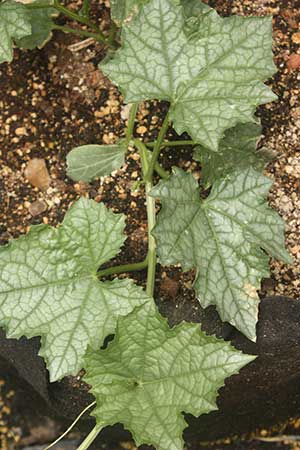This article was originally published in Garden Culture Magazine UK22.
The luffa is in the same family as gourds, cucumbers, melons, and squash. Their black seeds resemble oversized watermelon seeds and can benefit from a day’s soak in clean water before planting. Luffas require a long (5-7 month) frost-free growing season. You can start them early indoors before the last frost, though the young plants need careful hardening off when moved outside after the danger of frost is past. They are somewhat prone to transplant shock, but by taking care to disturb the roots as little as possible, this can generally either be avoided or at least kept relatively mild.
Luffas (also known as loofahs or dishrag gourds) produce the versatile luffa sponges in USDA zones 6 or higher.
What You Will Need
Luffas are vining plants, so small individual container trellises will help begin training seedlings started indoors. They can be grown in the ground or in containers with a capacity of at least 20 liters (5-gallons). When planted outdoors, they are frequently placed within reach of a sturdy trellis or chain link fence, as the vines commonly grow 4.5 – 9 meters (15’ – 30’) long and the luffa produces fairly heavy fruits, like a cucumber of equivalent size, until they start to dry out. Luffas hanging from a support tend to grow straighter than those on the ground, which have a tendency to curl as they develop.

Pollination
As luffas are monoecious, they have separate male and female flowers that appear on the same plant. The flowers of both genders are an intense, attractive yellow. The male flowers are found along long stems in clusters of varying maturities and the female flowers have a visible seed pod at the base. If the female flower becomes pollinated, it will develop into a luffa gourd. The flowers mature roughly in order of development, from stem bottom to tips. They are attractive to a variety of pollinators, including ants, and are a favorite of several types of bees. It is also possible to hand-pollinate by removing a recently opened male flower and using it to gently dust the stigma on the pistil of an opened female flower. To help coordinate an overlap in bloom maturity, it produces many more males than female flowers.
Harvesting
If desired, you can harvest and eat immature luffas, which taste similar to summer squash or zucchini. One of the common names of immature luffas is “Chinese okra,” which reflects this. If used for cooking, the young, tender luffas are desirable – once the fibers have started to develop, it is considered too mature for eating.
Luffas grown for their fiber are allowed to fully mature and are harvested only after they have dried (or close to it) on the vine. The dark green skins will lighten to first a light green, and then to a mottled yellow and brown indicating readiness for harvesting. Luffas ready for harvesting are light in weight and the skin feels ready to separate from the fiber beneath. Being intolerant to freezing, any luffas not ready for harvest will generally be a loss shortly after the first hard frost.
Once They’re Out Of The Garden…
To clean the luffas and prepare them for storage or use, first peel off the outer skin. This exposes the fibrous xylem network that comprises the sponge. The skin usually isn’t difficult to remove and is easily pulled off in chunks using only your fingers.

To save the seeds, select the best luffas from the harvest. Cut one end open to shake or rinse out the seeds. Luffas generate many seeds per gourd, so after the first successful harvest, there is generally no shortage for the following year, even keeping only the best.
Rinse the luffa sponges well to remove any remaining gel and seeds from the fibers. If desired, a short bath in a dilute bleach solution can whiten the fibers and even out discolorations. Dry the luffas completely, and either put them to use or store them in a container to protect from dust and moisture. Luffa sponges have a very long shelf life when kept clean and dry.
So Many Uses
The prepared luffa sponges have a variety of uses, and growing luffas instead of buying them can result in substantial cost savings. If purchased at a bath and body store, a single luffa sponge may well cost as much, or more than, an entire pack of luffa seeds.

Luffas are often cut to convenient sizes and used to scrub bodies or dishes. Luffas sold commercially for this purpose have proven so popular that a plastic mesh “luffa” was designed and sold as a cheaper, less ecological, alternative. Luffas used as a washing aid will last longer and stay cleaner when allowed to dry completely, regularly. Rotating between a few different sponges can allow longer drying times between uses.
A less well-known (but personal favorite) use of luffa sections is as starting plugs for seedlings. The interior of a slice of luffa has a distinctive pattern of holes, which can be packed with a moist potting mix or coco coir. The fibers of the luffa provide an exterior wall which allows using each as small, free-standing bottomless fiber pots. They are sturdier than conventional homemade pressed soil cubes and eliminate the need of a binder as is found in commercial plugs. They are also completely biodegradable and as renewable as your next harvest of luffas. The openings in the fibrous sides allow for air pruning, and they adapt to growing in soil or hydroponic use. The rounds can also be cut and used as an alternative to collars for rooting cuttings in a cloning machine.
People have cultivated luffas for food and as a utility plant for thousands of years, with good reason. With minimal processing, it provides useful fiber in a convenient shape.